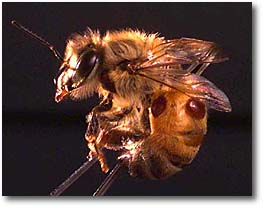
 |
|
|
A honey
bee sting. The sting detaches from the bee and remains in the flesh of
the person stung, where it continues to pump in venom and attracts more
bees to sting. (credit)
|
Africanized honey bees (AHB) were first discovered in Arizona when a colony, established in the roof of a Tucson house, stung a small dog to death on 6 June 1993. Experienced beekeepers and federal and state scientists who examined the remains of the colony suggested the colony was between 4 and 8 months old, placing its arrival into the state possibly as early as October, 1992. This was the second state in the U.S., after Texas, to confirm the natural spread from Mexico of this non-native species.
By the end of 1993, the Arizona Department of Agriculture had recognized 57 AHB colonies from central and southern Arizona. Ten of the AHB colonies detected were involved in stinging incidents, none leading to human fatalities. By midyear 1995, 95 AHB colonies had been detected, 28 involving stinging incidents.
Then the first human
fatality from AHB in Arizona occurred on 6 Oct 1995, east of Phoenix, when
an 88 year old woman was stung over 1000 times. A second fatality, a 66
year old man stung approximately 130 times, occurred only 12 days later,
also near Phoenix. Elderly people are at greater risk from the bee venom.
 |
|
|
Africanized honey bees are the result of crossbreeding between European and African strains of honey bees. In the 1950's, Brazilian geneticists reasoned that bees from tropical Africa might be better suited for the climate of tropical South America than were the European honey bees, whose performance was disappointing.
Unfortunately, Africanized bees were released from the breeding program before selective breeding was completed against the stronger defensive behavior which characterizes African bees. The AHB has taken to its new environment with vigor. They spread prodigiously since their release, with the leading edge advancing of up to 300 miles per year through the tropics of South and Central America. Meanwhile, but few colonies of AHB turned up in the U.S, accidentally transported on shipments of materials from South and Central America
The first time that a swarm of AHB was verified to have entered the United States on its own was in Hidalgo, Texas in October, 1990. The bee has since spread north and west through Texas and northern Mexico and currently is known to be in the 4 states bordering Mexico. Many sharply different predictions have been made as to how far AHB will eventually spread into the US. Fortunately the initial rapid expansion seems to have slowed.
Abridged from an article in California Agriculture 51:22-25. For further reading: the complete version of this article appears at the university site of one of the co-authors, entomologist, Kirk Visscher.
  |
Texas - 10/90
|
 |
|
Source: Information Staff, Agricultural Research Service, U.S.D.A. |

|
Northwest Fire District's
Captain John Estes of Tucson, Arizona uses a wide spray of water and a
chemical
wetting agent as a means of subduing Africanized bees. Looking on is
Eric Erickson from the Agricultural Research Service of the U.S. Department
of Agriculture who taught this method of controlling aggressive bee swarms
to fire departments throughout Arizona. The wetting agent acts on the waxy
outer body of the bee, like soap cuts through grease. The water can then
enter the body, in effect drowning the bee.
|
 |
|
|
What
is the Africanized honey bee? This site covers identification, economic,
stings, habitat and what-to-do questions.
from Agriculture
Communications at Texas A&M Univ.
Africanized "killer" bees have fallen prey to a deadly predator of their own- parasitic mites whose infestation has dropped their wild colony numbers by as much as 70 percent statewide. (Posted Feb 1998.)
Killer Bee Database - 200 links